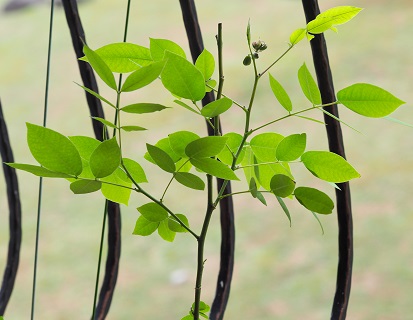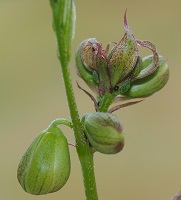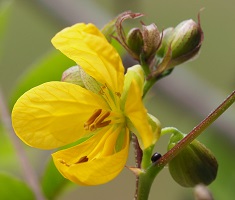| Home | Nature Weekly Index |
29 March 2020 | Senna occidentalis | Coffee Senna |
 I rescued a Coffee Senna (Senna occidentalis) plant from
the wild in January. It was a semi-matures plant about 30 centimetres in height and was already in fruiting
condition. It stood prominently by the side of a foot path that led to a park. Based on past observations, any
unwanted vegetation along the path will be removed at a regular interval which meant that this plant will be
gone very soon if left alone. As there was a heavy rain before I found the plant, it was not too hard to
unearth the plant from the softened soil.
I rescued a Coffee Senna (Senna occidentalis) plant from
the wild in January. It was a semi-matures plant about 30 centimetres in height and was already in fruiting
condition. It stood prominently by the side of a foot path that led to a park. Based on past observations, any
unwanted vegetation along the path will be removed at a regular interval which meant that this plant will be
gone very soon if left alone. As there was a heavy rain before I found the plant, it was not too hard to
unearth the plant from the softened soil.
Back home, I quickly placed it in a mid-size pot. The plant got accustomed to the potted environment relatively fast. The lone greenish seedpod matured subsequently and more flowers started to bloom. Unfortunately, I had to be away for 2 weeks in late February. To try to keep it alive till I returned, I cut away the upper portion of the plant leaving just the lower part of the stem intact, removes any remaining leaves and wetted the soil thoroughly. At my returned, the soil was very dry as expected. I quickly poured water onto the soil and fortunately within a week, the plant was back to life again with new shoots appearing on the stem. Another 2 weeks later, it started to flower again.

 Someone had grown a few of this plant in the park. The rain water might have brought a seed to the location
where I found the plant. With it safely in my pot, I started to read up more on this plant.
Someone had grown a few of this plant in the park. The rain water might have brought a seed to the location
where I found the plant. With it safely in my pot, I started to read up more on this plant.
The origin of this plant is either stated as unknown or the tropical and subtropical regions of the America. It is naturalised species in Singapore according to the Singapore Flora checklist published in 2009. However, I rarely find them in the wild. Most of the live specimens that I saw were cultivated ones. The plant is deemed as an environmental weed in some countries. But for others such as India and Africa, it is considered to be a traditional medicinal plant. The young leaves, immature seedpods and flowers were reported to be consumed as a vegetable. Though not related to the coffee plan (Coffea liberica), the seeds are reported to be used as a coffee substitute and hence the common name, Coffee Senna. The fresh seeds are reported to be toxic to animals [1, 2] but the toxicity seemed to disappear after heating. At least one fatal case in an adult linked to the consumption of the leaves of this plant was reported from India [3]. Cases of poisoning in children related to this plant had also been reported from India [4, 5]. Therefore, care should be exercised when using this plant as part of traditional medicine.
Other noteworthy information about this plant:
- The whole genome of this plant had already been decoded by a group of Korean researcher with the results published recently [6].
- From my past observations, the bean bug, Riptortus pedestris feeds on this plant.
References:
[1] Barth AT, Kommers GD, Salles MS, Wouters F, de Barros CS. Coffee Senna (Senna occidentalis) poisoning in cattle in Brazil. Vet Hum Toxicol 1994;36(6):541-545. | Read abstract |
[2] Oliveira-Filho JP, Cagnini DQ, Badial PR, Pessoa MA, Del Piero F, Borges AS. Hepatoencephalopathy syndrome due to Cassia occidentalis (Leguminosae, Caesalpinioideae) seed ingestion in horses. Equine Vet J 2013;45(2):240-244. | Read abstract |
[3] Ish P, Rathi S, Singh H, Anuradha S. Senna occidentalis poisoning: an uncommon cause of liver failure. ACG Case Rep J 2019;6(4):e00035. | Read article |
[4] Panigrahi G1, Tiwari S, Ansari KM, Chaturvedi RK, Khanna VK, Chaudhari BP, Vashistha VM, Raisuddin S, Das M. Association between children death and consumption of Cassia occidentalis seeds: clinical and experimental investigations. Food Chem Toxicol 2014;67:236-248. | Read abstract |
[5] Vashishtha VM, Kumar A, John TJ, Nayak NC. Cassia occidentalis poisoning causes fatal coma in children in western Uttar Pradesh. Indian Pediatr 2007;44(7):522-525. | Read article |
[6] Kang SH, Lee HO, Ahn BO, Kim CK. The complete mitochondrial genome sequence of Senna occidentalis (Fabales: Fabaceae). Mitochondrial DNA Part B 2019;4(1):85-86. | Read article |